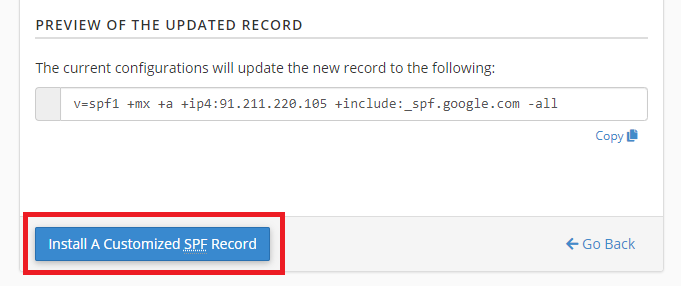The SPF mechanism was explained in other article about spf and dkim protection. In this guide we will show you how to add a new SPF record.
Adding SPF through”Email Deliverability”
1. First, navigate to “Email Deliverability” in cPanel.
Once there, click the “Manage” button on the bar corresponding to the domain in question.

2. Next, go to the SPF section and click “Customize.”

3. At the bottom of the settings, you’ll find the option Include List (INCLUDE) – click “Add A New ‘+include’ Item“. Next, enter the record you want to add. For demonstration purposes, we use a Google record.
If You want to add IP address instead, look for Additional IP Address Blocks (IPv4) section.

4. Now head to the bottom of the page, You will see a preview of customized SPF record. To submit changes, click “Install a customized SPF record”.

Changing ~all parameter to -all
To change the parameter from ~all to -all or vice versa, go to the SPF section just like when adding a new record. However, in this case, simply select the option shown in the image below. Submit changes by clicking „Install a customized SPF record”.

After completing these steps, the ~all parameter has been changed to -all.
Modifying the SPF Record in Zone Editor
1. To directly edit the SPF record, go to “Zone Editor”, then click “Manage” next to the selected domain.

2. Now look for TXT type record with SPF values. Click “Edit“.

Now you can manually modify the SPF record. For example, to add authorization for Microsoft Outlook, we can add the fragment: include:spf.protection.outlook.com – additional entries should be placed between v=spf1 +a +mx and -all.
You can also add an SPF record (if it does not exist) using the Zone Editor by creating a new TXT record with the appropriate value. However, it is important to remember that a domain can have only one SPF record. Any new rules should be added to the existing record. If a domain has two separate SPF records, recipients servers will treat mailing from your domain as unauthorized, and messages may either not be delivered or end up in the spam folder.
- DNS Anycast – What It Is And How It Works - November 26, 2024
- DNSSEC – basic information. - September 29, 2024
- Fake e-mails from hackers and other dangerous messages. - September 29, 2024

